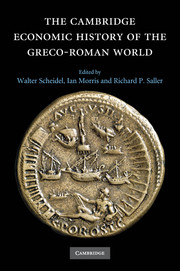Book contents
- Frontmatter
- 1 Introduction
- Part I Determinants of Economic Performance
- 2 Ecology
- 3 Demography
- 4 Household and Gender
- 5 Law and Economic Institutions
- 6 Technology
- Part II Early Mediterranean Economies and the Near East
- Part III Classical Greece
- Part IV The Hellenistic States
- Part V Early Italy and the Roman Republic
- Part VI The Early Roman Empire
- Part VII Regional Development in the Roman Empire
- Part VIII Epilogue
- Bibliography
- Index
- Map 1.1 The Mediterranean basin"
- Map 10.1 Greek and Phoenician trade in the period of the Persian Wars"
- Map 11.1 The Achaemenid empire"
- Map 12.1 Greece and Asia Minor"
- Map 15.1 The Seleucid empire"
- Map 16.1 Greco-Roman Egypt"
- Map 20.1 The Roman empire at the accession of Vespasian"
- References
6 - Technology
from Part I - Determinants of Economic Performance
Published online by Cambridge University Press: 28 March 2008
- Frontmatter
- 1 Introduction
- Part I Determinants of Economic Performance
- 2 Ecology
- 3 Demography
- 4 Household and Gender
- 5 Law and Economic Institutions
- 6 Technology
- Part II Early Mediterranean Economies and the Near East
- Part III Classical Greece
- Part IV The Hellenistic States
- Part V Early Italy and the Roman Republic
- Part VI The Early Roman Empire
- Part VII Regional Development in the Roman Empire
- Part VIII Epilogue
- Bibliography
- Index
- Map 1.1 The Mediterranean basin"
- Map 10.1 Greek and Phoenician trade in the period of the Persian Wars"
- Map 11.1 The Achaemenid empire"
- Map 12.1 Greece and Asia Minor"
- Map 15.1 The Seleucid empire"
- Map 16.1 Greco-Roman Egypt"
- Map 20.1 The Roman empire at the accession of Vespasian"
- References
Summary
ancient technology in modern historiography
Ancient technology has been a subject of controversial scholarly debate since the beginning of the twentieth century. So far, a consensus has proved unattainable, whether about the issues and topics of a modern history of ancient technology, about the criteria of evaluation of technological developments in pre-industrial societies, or about the actual spread of technological innovations. In such circumstances, this chapter must begin by taking up a position in relation to the views expressed in earlier research, and at the same time offering some methodological justification for my own view.
Almost all work on the history of technology published before 1984 espoused the opinion that technological development in antiquity never implemented advances that were actually quite possible; that ancient technology had, on the whole, been characterized by stagnation; and that it had only few inventions to show which could be compared in importance to the accomplishments of the ancient civilizations in such areas as literature, art, philosophy, mathematics or medicine. It was further held that those few technological innovations which are documented had scarcely been put to economic use, and had therefore only had scant influence on work, production, and productivity. Various reasons were given for the perceived primitive and backward nature of ancient technology, such as a reverence for nature that was rooted in religion, the preponderance of thought structures shaped by rhetoric and therefore unsuitable for the understanding of technical facts, or the elitist self-perception of ancient scholars who had had no interest in making practical use of their scientific knowledge.
Keywords
- Type
- Chapter
- Information
- The Cambridge Economic History of the Greco-Roman World , pp. 144 - 172Publisher: Cambridge University PressPrint publication year: 2007
References
- 13
- Cited by

